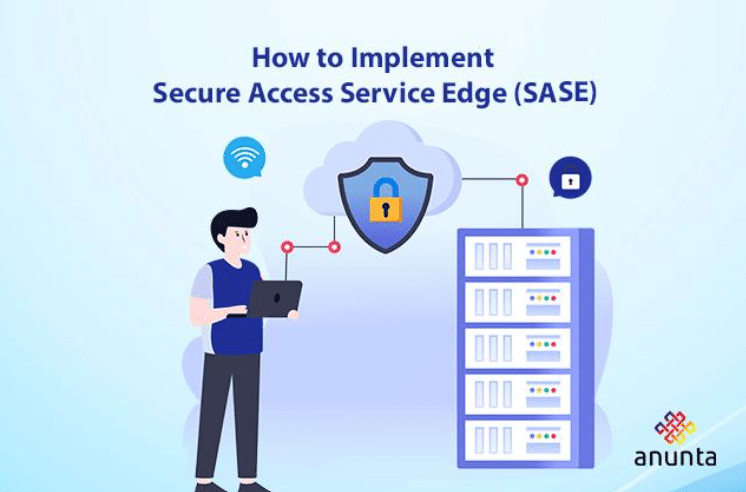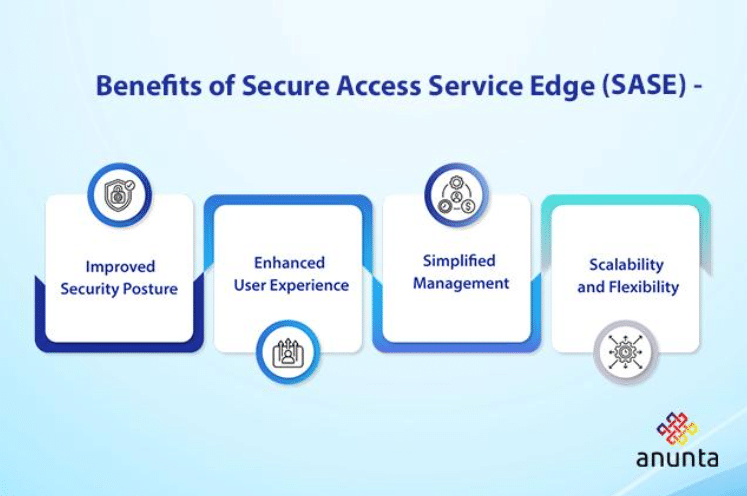
There is a major shift in how network security and connectivity are approached when it comes to implementing Secure Access Service Edge (SASE). It is a cloud-native service that integrates numerous network security functions with the goal of offering a full modern digital organization’s safety and access control. This blog will explain what SASE means, its main pillars and provide a step by step implementation process for organizations.
SASE stands for Secure Access Service Edge, which is where wide-area networking (WAN) and network security services merge into a cloud-delivered service model. In the past, organizations managed discrete security solutions such as firewalls, secure web gateways (SWG), and virtual private networks (VPN). These functionalities are now unified in SASE, thereby providing similar security policies and access controls irrespective of the end user’s location.
The key components of SASE typically include:
SD-WAN (Software-Defined Wide Area Network): Provides efficient and flexible connectivity between enterprise branches, data centers, and cloud resources.
Firewall as a Service (FWaaS): Cloud-native firewalls that enforce security policies consistently across all network edges, including branch offices and remote users.
Secure Web Gateway (SWG): Offers protection from web-based threats by filtering and inspecting internet traffic for malicious content and enforcing acceptable use policies.
Cloud Access Security Broker (CASB): Controls access to cloud services and secures data stored in cloud applications, ensuring compliance with security policies.
Zero Trust Network Access (ZTNA): Validates every access request based on identity, device posture, and other contextual factors, regardless of the user’s location.
Implementing SASE provides several key benefits for organizations:

Improved Security Posture: SASE consolidates security controls, enabling consistent policy enforcement across all edges.
Enhanced User Experience: By optimizing network performance and reducing latency, SASE improves application access for remote and branch users, leading to better productivity.
Simplified Management: Centralized policy management and monitoring through a unified console streamline IT operations, reducing complexity and operational overhead.
Scalability and Flexibility: Cloud-native architecture allows organizations to scale security and network capabilities dynamically based on evolving business needs and user demands.
Follow these key steps to implement Secure Access Service Edge (SASE):
Before implementing SASE, conduct a comprehensive assessment of your organization’s existing network architecture, security posture, and business requirements. Identify critical applications, data flows, and user access patterns that will influence your SASE deployment strategy.
Establish clear security and access policies that align with your organization’s risk tolerance and compliance requirements. Define policies for data protection, user authentication, application access, and acceptable use to guide the configuration of SASE components.
When evaluating SASE providers based on their ability to meet your organization’s specific security, performance, and compliance needs, consider factors such as global reach, service-level agreements (SLAs), integration capabilities with existing systems, and vendor reputation. Anunta, known for its robust integration capabilities and strong reputation in managed SASE solutions, offers compelling options in this regard.
According to Gartner, secure work from anywhere (remote, branch, or campus) will emerge as a top business priority for CIOs and chief information security officers (CISOs) By 2027.
Design a scalable and resilient SASE architecture that accommodates current and future network and security demands. Consider factors such as edge locations, traffic patterns, redundancy requirements, and integration points with SD-WAN, CASB, and other components.
Deploy Secure Access Service Edge components according to the designed architecture. Configure SD-WAN for optimized connectivity, deploy FWaaS and SWG for consistent security enforcement, integrate ZTNA for secure access, and implement CASB for cloud application security.
Conduct thorough testing and validation of the implemented SASE solution to ensure it meets performance, security, and usability requirements. Test scenarios should include real-world traffic patterns, security incidents, and scalability tests to identify and address potential issues.
Implement continuous monitoring and optimization practices to maintain the effectiveness of your SASE deployment. Monitor network and security metrics, user activity, and threat intelligence to detect anomalies and fine-tune security policies and configurations as needed.
Provide training and educational resources to users and administrators on the benefits and proper use of the SASE solution. Emphasize best practices for secure remote access, data protection, and compliance with organizational policies.
Enhancing network security for corporate organizations and improving performance as well as user experience are some of the reasons why companies implement Secure Access Service Edge (SASE). This unifies cloud-nativeservice consolidating diverse security functions and in turn providing better visibility, control, and scalability over distributed environments.
At Anunta, we help enterprises simplify this transition with managed SASE solutions, combining expertise in cloud migration, managed endpoint services, and modern workplace management. With the right strategy, businesses can not only strengthen security but also unlock scalability, agility, and cost efficiency for the future of work.
A: Implementing Secure Access Service Edge offers several benefits, including enhanced security through consolidated policies and visibility, improved user experience with optimized application performance, simplified management via centralized controls, and scalability to meet evolving business needs.
A: SASE integrates components like SD-WAN for efficient connectivity, FWaaS and SWG for consistent security enforcement, ZTNA for secure access, and CASB for cloud application security.
A: When selecting a SASE provider, prioritize robust security features like FWaaS and ZTNA, along with high-performance global infrastructure. Ensure seamless integration with existing systems and scalability to support future growth. Anunta, renowned for its strong reputation and expertise in managed SASE solutions, offers compelling options that align with your organization’s specific needs and compliance standards effectively.
A: To ensure a smooth transition, conduct a thorough assessment of current infrastructure and requirements, define clear security and access policies, design a scalable architecture, perform comprehensive testing, and provide training to users and administrators.
Q: What are some common challenges organizations face when implementing SASE?
A: Common challenges include integrating disparate security functions into a unified architecture, ensuring consistent policy enforcement across all edges, managing complexity during the transition phase, and addressing potential performance issues related to network latency and bandwidth utilization. Working closely with experienced Secure Access Service Edge (SASE) providers and conducting thorough planning can mitigate these challenges effectively.
Research Review with Anunta’s CTO | Jan 14 | 12PM PST/3PM EST